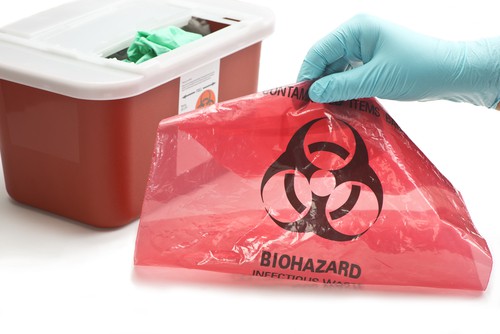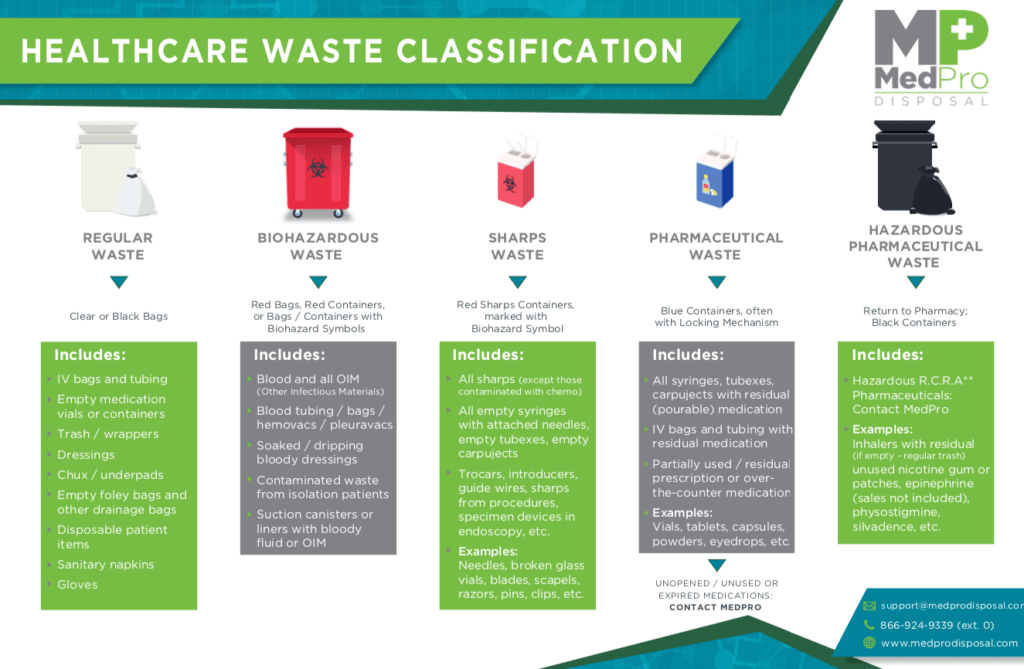Sustainable Solutions for Medical Garbage Disposal
The appropriate administration and disposal of clinical waste is crucial in maintaining a lasting and safe health care system. This introduction will certainly discover various lasting options for clinical waste disposal, consisting of waste segregation and sorting, on-site waste therapy systems, reusing and reuse programs, waste-to-energy conversion technologies, as well as partnership and education campaigns.
Waste Partition and Sorting
The procedure of waste partition and sorting is vital in guaranteeing appropriate management and disposal of clinical waste. Clinical waste is identified into different classifications based upon its possible danger to human wellness and the atmosphere. Correct segregation and sorting of waste help to decrease the risk of contamination and ensure that each type of waste is handled and gotten rid of properly.
The very first action in waste segregation and sorting is to identify and separate various sorts of clinical waste at the factor of generation. This involves recognizing the various groups of waste, such as contagious waste, sharps waste, pharmaceutical waste, and chemical waste. medical waste removal. Each category calls for particular dealing with and disposal approaches to stop harm to healthcare workers, individuals, and the atmosphere

On-site Waste Treatment Systems
Continuing from the previous subtopic on waste partition and sorting, an effective remedy for lasting medical waste disposal is the application of on-site waste therapy systems - medical waste removal service. These systems allow medical care facilities to treat their clinical waste on-site, decreasing the demand for transportation and disposal at off-site facilities. On-site waste therapy systems generally consist of modern technologies such as autoclaves, microwave systems, or chemical disinfection systems
Autoclaves, typically used in medical care setups, use high-pressure steam to disinfect and treat clinical waste. This procedure properly eliminates germs, infections, and various other potentially dangerous bacteria, making the waste risk-free for further handling and disposal. Microwave systems, on the various other hand, use microwave radiation to warm and treat the waste, achieving similar results to autoclaves.
Chemical disinfection devices involve making use of chemicals to disinfect and deal with clinical waste. These units can make use of numerous disinfectants, such as chlorine-based services, to counteract microorganisms and lower the threat of contamination. The treated waste can after that be securely taken care of in regular waste streams or undergo further treatment, such as shredding or incineration.
Executing on-site waste treatment systems uses a number of advantages. It decreases the ecological impact linked with transporting medical waste to off-site facilities, reducing carbon emissions and the danger of crashes during transport. Additionally, it gives healthcare centers with even more control over the treatment procedure, making certain compliance with guidelines and reducing the potential for unapproved access to sensitive medical waste.
Recycling and Reuse Programs
To even more boost lasting medical waste disposal methods, health care centers can implement recycling and reuse programs, building on the structure of on-site waste therapy systems. Recycling and reuse programs use an additional layer of environmental obligation by diverting medical waste from landfill and finding alternative usages for sure products.
One trick facet of reusing and reuse programs is the segregation of waste at the source. medical waste removal service. By executing correct waste segregation procedures, medical care centers can divide recyclable materials, such as plastics, steels, and glass, from non-recyclable waste. This permits the reliable recycling of these products, lowering the need for virgin sources and decreasing the ecological effect of clinical waste disposal
Along with recycling, health care centers can check out possibilities for recycling certain clinical things. Single-use items like surgical drapes and dress can be sterilized and recycled, minimizing the demand for new materials and decreasing waste generation. Reusable sharps containers can additionally be utilized, reducing the amount of plastic waste created from non reusable containers.
Applying recycling and reuse programs needs proper framework and training - WasteX Medical Waste Disposal. Health care centers must purchase appropriate recycling containers, segregation systems, and sanitation equipment, along with guarantee team are informed on correct waste monitoring methods
Waste-to-Energy Conversion Technologies
One prospective method to address clinical waste disposal sustainably is with the application of waste-to-energy conversion technologies. These innovations offer a promising option to the expanding trouble of clinical waste, which poses substantial ecological and public health risks. Waste-to-energy conversion involves transforming the organic elements of medical waste right into energy, such as warmth or electrical energy, with different processes like incineration, gasification, and pyrolysis.
Incineration is the most frequently used waste-to-energy technology for medical waste disposal - WasteX Medical Waste Disposal. It involves the controlled combustion of waste at high temperature levels, transforming it right into ash, gases, and heat. This warmth can be made use of to produce steam, which can after that be transformed right into electricity
Pyrolysis and gasification are more recent technologies that offer more eco-friendly options to incineration. Pyrolysis involves heating the waste in the lack of oxygen, leading to the manufacturing of gases and char. Gasification, on the various other hand, transforms waste right into a synthetic gas or "syngas" that can be made use of as a gas for power generation or various other industrial procedures.
These waste-to-energy conversion technologies not just lower the quantity of clinical waste however likewise supply a resource of renewable resource. In addition, they can help lower greenhouse gas emissions and reliance on nonrenewable fuel sources (WasteX Medical Waste Disposal). It is vital to make sure that these technologies are carried out with correct discharges control procedures to minimize any kind of potential adverse influences on air high quality and public health.
Partnership and Education Initiatives
Cooperation amongst stakeholders in the healthcare market is crucial for implementing lasting options for clinical garbage disposal. In order to more effectively address the challenges connected with medical waste administration, it is vital for healthcare facilities, waste management firms, regulatory authorities, and various other relevant celebrations to collaborate.

In addition, education and learning initiatives play a vital duty in advertising sustainable methods. Health care professionals require to be knowledgeable about the ecological impact of improper waste administration and the importance of applying sustainable solutions. Educating programs and academic materials can help them recognize the appropriate segregation of waste, the usage of green alternatives, and the benefits of waste-to-energy conversion technologies.
Collaboration and education and learning can also promote the growth of guidelines and guidelines for clinical waste disposal. By interacting, stakeholders can add to the creation of detailed policies that make certain risk-free handling, transport, and therapy of medical waste.
Final Thought
In conclusion, taking on sustainable solutions for clinical waste disposal is crucial in order to decrease the negative effect on the atmosphere and public wellness. Waste segregation and sorting, on-site waste therapy systems, recycling and reuse programs, waste-to-energy conversion innovations, and cooperation and education campaigns are very important approaches to achieve this objective. Implementing these options requires partnership in between healthcare facilities, waste monitoring companies, and government firms, as well as constant education and learning and awareness campaigns.
The procedure of waste partition and sorting is essential in making certain proper administration and disposal of clinical waste.The initial step in waste segregation and sorting is to recognize and separate different types of medical waste at the factor of generation. This entails recognizing the various classifications of waste, such as contagious waste, sharps waste, pharmaceutical waste, and chemical waste.Proceeding from the previous subtopic on waste partition and sorting, an effective service for sustainable clinical waste disposal is the implementation of on-site waste treatment systems. The treated waste can then be safely disposed of in routine waste streams or undertake more therapy, such as shredding or incineration.